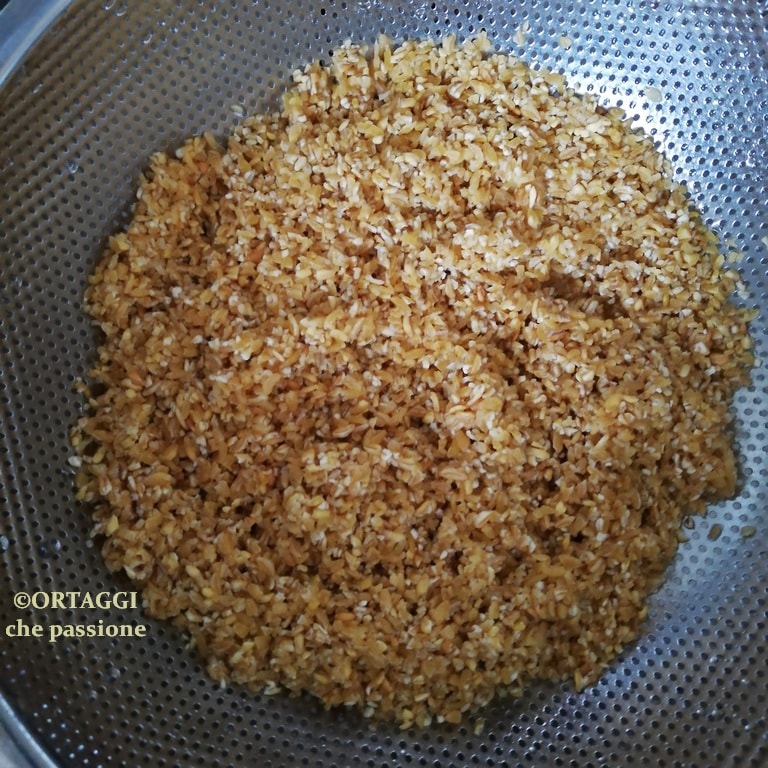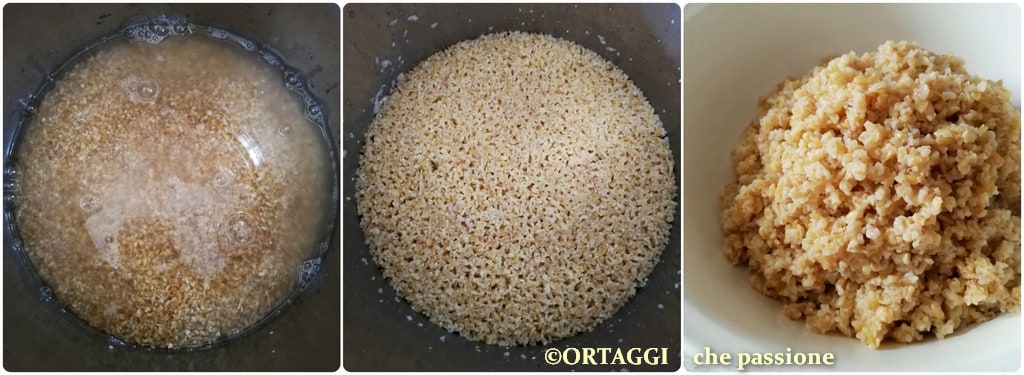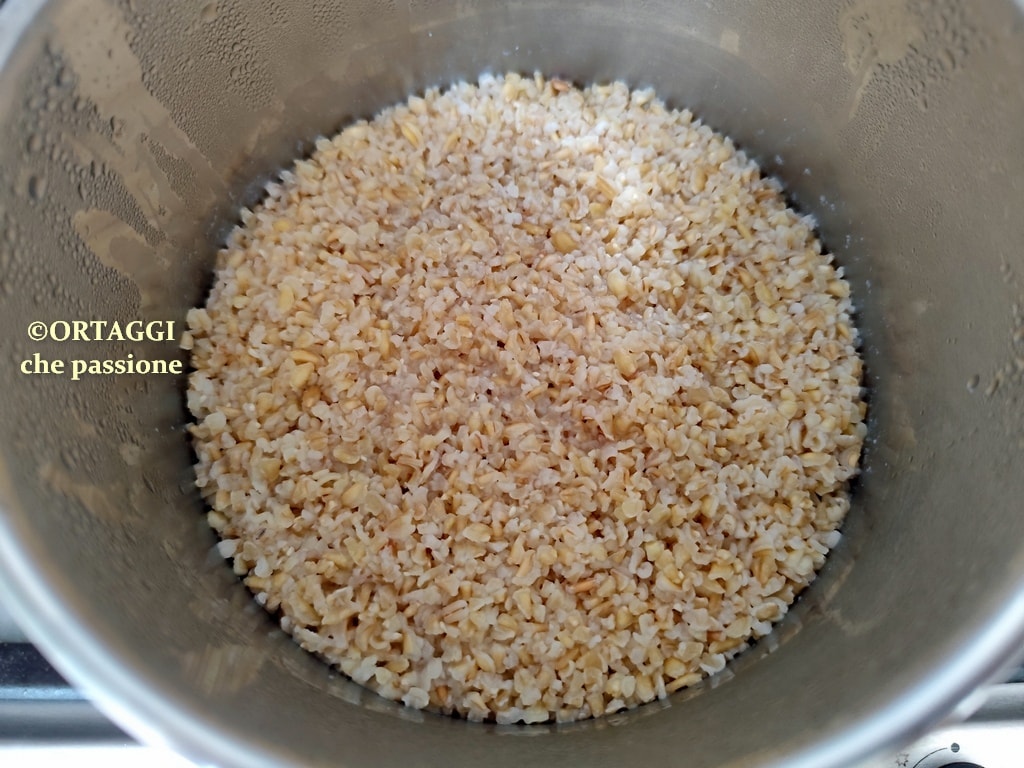The cooking time for bulgur is short, usually around 15 minutes, making it ideal for quick preparations. There are two main types of bulgur, the coarse type which has a thicker consistency and longer cooking time, generally used for soups or vegetable dishes, and the fine type, which has a thinner consistency and cooks in just 10 minutes, ideal for salads and pilaf.
The recommended serving per person is 50-80 grams, depending on appetite and the chosen recipe.
In absorption cooking, water is essential: generally, double the volume of cracked wheat is used. For example, for 100 grams of bulgur, 200 ml of water or more is used. Or for 1 (one) cup of bulgur, 2 (two) cups of water are used.
In summer, bulgur is delicious in main dishes and cold salads, while it perfectly complements hot winter soups, adding substance and a rustic touch. Ideal also as a base for a healthy and energetic breakfast or as a rice substitute in a risotto.
What is it? Bulgur (bulghur, boulghor, or cracked wheat) is a cereal made from sprouted whole durum wheat. After being steamed and dried, the grain is ground into small pieces. This process gives it a crunchy texture and significantly reduces its cooking time.
Bulgur is also prepared raw. In this case, the durum wheat grains are selected and chopped without any thermal treatment. This type of grind is coarser than cooked bulgur and, to use it in cooking, it must be cooked for 15-20 minutes before incorporating it into recipes.
Bulgur, the Turkish term for “boiled barley,” is a cereal originating from the Middle East.
Rich in fiber and protein, this pre-cooked and crushed cereal is very filling and generally improves intestinal well-being. Its versatility makes it a beloved ingredient in many international cuisines; it adapts to every season and every dish!
GRAIN cooking
- Difficulty: Easy
- Cost: Cheap
- Preparation time: 2 Minutes
- Portions: 4
- Cooking methods: Stovetop, Pressure cooker
- Cuisine: Healthy
- Seasonality: All seasons
- Energy 256.50 (Kcal)
- Carbohydrates 56.90 (g) of which sugars 0.31 (g)
- Proteins 9.22 (g)
- Fat 1.00 (g) of which saturated 0.17 (g)of which unsaturated 0.54 (g)
- Fibers 9.38 (g)
- Sodium 503.43 (mg)
Indicative values for a portion of 228 g processed in an automated way starting from the nutritional information available on the CREA* and FoodData Central** databases. It is not food and / or nutritional advice.
* CREATES Food and Nutrition Research Center: https://www.crea.gov.it/alimenti-e-nutrizione https://www.alimentinutrizione.it ** U.S. Department of Agriculture, Agricultural Research Service. FoodData Central, 2019. https://fdc.nal.usda.gov
BULGUR – absorption cooking
PORTIONS per person:
– 1.4-1.8 oz if added to soup or used as a side dish or in salads
– 2.5-2.8 oz if used as a main dish or in poke
(in the recipe below, I used 2.64 oz per person)
- 10.6 oz bulgur
- 1 tsp fine salt (more or less based on personal taste)
- 20.3 oz water
HOW TO CALCULATE the amount of WATER
– 1 cup of bulgur = 2 cups of water
– 100 g of bulgur = 200 g of water
Tools
- Pan tall and narrow with lid
BULGUR – easy and quick cooking
The cooking of bulgur is similar to that of couscous.
Always rinse the cracked wheat thoroughly under running water before use to remove excess starch.
If desired, it can be lightly toasted for a few minutes in a pan before adding it to the water.

Pour the rinsed bulgur into the pressure cooker and cover it with the necessary water (salt now or at the end of cooking).
Close the pressure cooker and turn on the heat. From the classic whistle, lower the flame and continue gentle cooking. Once the cooking time is over, turn off the heat and let the pressure cooker release naturally before opening it only when the safety block has lowered, this will allow the cereal to continue cooking (a technique that also makes the opening of the pressure cooker less dangerous). If there is still some water left at the end of cooking, close the pot again and wait for the bulgur to absorb all the water.
How do you calculate the pressure cooker cooking time?
Generally, the cooking time in a pressure cooker is halved.
Instead, if, after turning off the heat, you let the pressure cooker release naturally (also to avoid being inundated by cooking steam), the times are reduced by a third. This saves energy and time.

– WITH COLD WATER
Pour the rinsed bulgur into a saucepan, cover it with cold water, and stir it quickly. Cover the saucepan with a lid and cook over low heat for about 15 minutes, so that the liquid is completely absorbed. If necessary, add more water during cooking. Once cooked, turn off the heat and let it rest in the saucepan until the liquid is fully absorbed.
– WITH HOT WATER
Place the water (or broth for a more intense flavor) in a pot, then bring it to a boil and salt it, turn off the heat and pour in the rinsed cracked wheat. Stir and cover with a lid, let rest for about 15 minutes or until the desired consistency is reached. Before serving, fluff with a fork.
Alternatively, pour the rinsed bulgur into a bowl and cover it with hot water. After salting and stirring, cover the bowl and let the bulgur soak. This will allow the cereal to swell and fully absorb the water.

WHAT IS THE RIGHT CONSISTENCY FOR COOKED BULGUR?
The bulgur should be tender but not mushy at the end of cooking.
After cooking, it is always better to cover the pot with a lid and let it rest for another 5 minutes or more to allow the bulgur to absorb any remaining liquid and become even more tender.
Once the bulgur is ready, fluff it with a fork to separate the grains and achieve a light and fluffy consistency. If desired, dress with extra virgin olive oil and/or lemon.
Transfer the rinsed bulgur to a microwave-safe container and add the water (or broth), using a ratio of 230 grams of water for every 100 grams of bulgur. Cover the container with a microwave-safe lid, leaving a small opening to allow air to escape.
Cook the bulgur at maximum power for 5-6 minutes. After this time, check the consistency of the cereal, and if necessary, continue cooking for another 2 minutes until the bulgur is tender but still slightly al dente. Once cooked, let it rest covered for a few minutes to allow it to absorb any residual liquid and reach the perfect consistency. Finally, fluff it with a fork.
Among the most common spices used with bulgur are CUMIN (adds an earthy touch), CORIANDER (offers a slightly citrusy aroma), black PEPPER or chili pepper (adds a hint of spiciness), CINNAMON (for a sweet and warm flavor), PAPRIKA (offers a smoky and colorful touch), TURMERIC (with its intense yellow color, can be used to add color). These spices can be added individually or in a mix to further enrich the dish. The use of spices depends on the type of dish you want to prepare and personal taste.
STORE cooked bulgur
After cooking, let the boiled bulgur cool at room temperature. Cooked bulgur can be stored in an airtight container in the refrigerator for up to 4 days.
FAQ (Frequently Asked Questions)
What is the difference between couscous and bulgur?
Couscous is a type of semolina pasta, typical of North Africa, while bulgur is whole wheat partially cooked and then dried, originating from the Middle East. Both are used in many recipes, but they have different textures and preparations.
Where can you find bulgur?
Bulgur can be bought in well-stocked supermarkets (generally in the ethnic or cereal and legume section), in herbal shops, in organic stores, or in exotic product markets.
What does bulgur taste like?
Bulgur has a slightly nutty flavor and a consistency similar to that of brown rice.
How much does bulgur cost per kg?
The cost of bulgur can vary depending on the place of purchase and the type of bulgur. Generally, the price ranges between 4 and 8 euros, but it can be higher for organic or special varieties.

